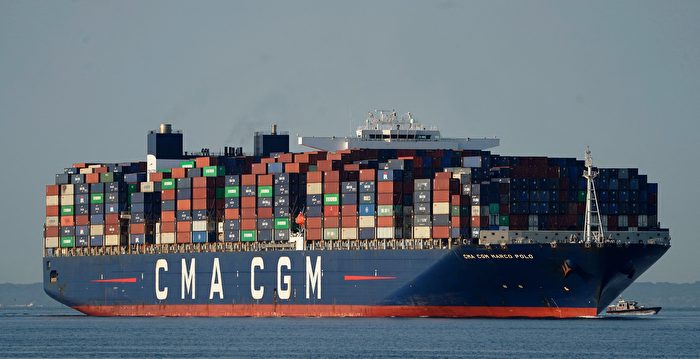[Epoch Times September 13, 2021](Epoch Times reporter Li Bing comprehensive report) At present, the price of China-US shipping has exceeded US$20,000/FEU, a year-on-year increase of more than 500%. At the same time, shipping giants such as CMA CGM have announced the freezing of freight rates. The recent surge in shipping costs not only affects the survival of Chinese foreign trade companies, but also exposes China to rare inflationary pressures.
According to the Global Container Freight Index launched by the Baltic Shipping Exchange and Freightos, as of September 12, the shipping prices of China/Southeast Asia-West Coast of North America and China/Southeast Asia-East Coast of North America continued to rise slightly, each exceeding the US$20,000 mark: They are US$20,586/FEU (40-foot standard container) and US$22,173/FEU respectively.
Compared with the same period last year, the prices have both increased by more than 500%.
On September 9, CMA CGM, the world‘s third largest container carrier, announced that it would freeze the spot market price of transported goods. CMA CGM said that although the group expects prices to rise in the next few months, the spot market freight rates for freight customers will remain at the current level within five months.
CMA CGM is a member of the Ocean Alliance and a major shipping company on North American routes. The three major shipping alliances-2M, THE Alliance and Ocean Alliance control more than 80% of the global container shipping market.
After CMA CGM announced the freezing of freight rates, another shipping giant Hapag-Lloyd also expressed “follow-up”.
However, Lars Jensen, a container shipping analyst at Vespucci Maritime, pointed out in a research report that the freezing of sea freight is only a freezing of spot prices. This does not necessarily rule out that surcharges will be increased. This has become an issue for importers and exporters. A heavy burden, and additional costs are usually excluded from the freight basis.
As for when shipping prices can really be lowered, Huo Jianguo, vice chairman of the China World Trade Organization Research Association, told CBN that it still depends on the trend of the epidemic. It should be difficult for the price to come down this year, because the price has risen and the epidemic situation has not improved significantly. In this case, I am afraid it will be next year.
Since the epidemic, due to factors such as shipping costs and the skyrocketing prices of raw materials, a Mr. Xiong, who is engaged in textile processing and export business in Yiwu, told Phoenix Finance: “Last year, the profit margin was still 10%, but now it is only 2%.”
At present, the soaring shipping cost directly affects the enthusiasm of Chinese foreign trade companies to take orders, making foreign trade orders a hot potato among foreign trade companies, and some have to give up orders.
21 Economic Net recently reported that in the face of such low profits, Zhou Ming, the person in charge of a foreign trade company in Tianjin, said that even in the annual peak season for foreign trade demand, there are already small shippers in the market who have no choice but to give up orders.
In addition to the pressure faced by foreign trade companies, GF Securities stated in a research report that rising shipping prices have been an important driver of global inflation this year, and China is facing inflationary pressures.
Recently, the prices of bulk commodities such as copper and iron ore in China have been rising all the way, and some have risen by more than 20%. The Chinese Communist Party’s official producer price index (PPI) in May increased by 9% over the same period last year, setting a new high in the past 13 years.
The pressure of rising prices of bulk commodities not only directly affects the capital side of enterprises, but also weakens profit margins, leaving some Chinese manufacturing industries in an embarrassing situation where the more orders they receive, the more losses they will suffer.
Editor in charge: Li Qiong#
.
